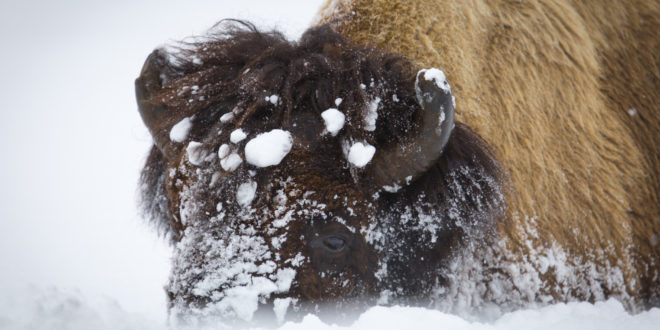Hunters have killed far fewer Yellowstone bison north and west of the park than they did at this time last year.
In addition, no bison have been shipped to slaughter.
When agencies under the Interagency Bison Management Plan met earlier this winter, they called for 600 to 900 bison to be culled. Under those guidelines, at least 372 bison needed to be hunted or shipped off to slaughter. According to the Bozeman Daily Chronicle, however, an estimated 130 to 170 bison have been taken by hunters:
The fickle balance varies from year to year. This year, following the season that saw the most bison killed in a decade, the balance has swung the other direction — at least so far. No bison have been shipped to slaughter, and hunters have taken fewer than 200.
“We’ve had several hunt teams go over and come back empty handed because the animals just aren’t out,” said Carl Scheeler, a wildlife manager for the Confederated Tribes of the Umatilla Indian Reservation in Oregon.
[…]
Tom McDonald, a wildlife manager with the Confederated Salish and Kootenai Tribes, said it’s all because of the weather.
“(This year) has just been one of those years where the migration’s been low,” McDonald said. “We may not hit the harvest goal this year.”
Last year, through hunting and slaughter, over 1,200 Yellowstone bison were killed, the most in roughly a decade. Following the winter, approximately 4,800 bison were counted in the park, down from approximately 5,500 the previous summer. Last summer’s survey also noted the decline in Yellowstone’s central herd, ostensibly safe from hunting and slaughter since that herd sticks around the Hayden Valley.
The decline in bison leaving the park comes as at the same time the Blackfeet Nation has joined five other tribes who have treaty rights to hunt bison outside Yellowstone. Although some officials expressed reservations about having additional hunters in the area, there reportedly have not been any “major problems,” according to the Chronicle:
Despite the muted activity, tribes have been testing a new method of managing hunting pressure on the Gardiner side. Tribal hunters are required to hunt on public land, and hunters have typically flocked to a sliver of land known as Beattie Gulch, which butts up against the Yellowstone border.
Over the years, locals have complained of constant gunfire, unsafe hunting practices and seeing too many trucks on the road. Various efforts to address the problems over the years have failed.
Tribal hunters adhere to their own tribe’s regulations and are policed by their own wardens, but four tribes agreed to a set of common regulations that applied only to those four tribes. It limits the number of their hunters that can be out at one time, prohibits all hunters from shooting at the same time and boosts cooperation between game wardens for different tribes.
McDonald, of the CSKT, which is part of the agreement, said it had led to a more structured hunt and seemed to be working OK but it was tough to judge its success in such a slow year. He said the time to test it is during the larger migrations, but the arrival of a few dozen Blackfeet hunters, who aren’t subject to the agreement, has thrown a wrench in the plan.
“Now was the time to truly vet it, but unfortunately we can’t with other people that aren’t party to it being on the landscape,” he said.
Bison hunting season will end next week for at least two tribes and Montana hunters, according to the Chronicle. Typically, hunting and slaughter ends by mid-to-late March, in anticipation of bison calving season.
 Yellowstone Insider Your Complete Guide to America's First National Park
Yellowstone Insider Your Complete Guide to America's First National Park





